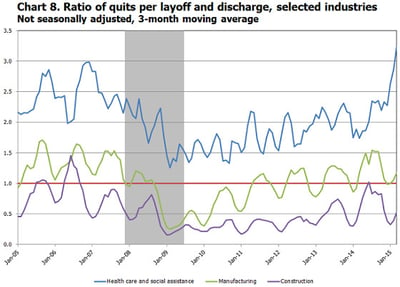 Source: Zywiak, W. (2010, June). U.S. healthcare workforce shortages: Caregivers. [full article]
Source: Zywiak, W. (2010, June). U.S. healthcare workforce shortages: Caregivers. [full article]
With the quit ratio of health care workers rising to its highest level since 2008 and with a national unemployment rate of 5.0% as of March 2016, operators of seniors housing and care properties are increasingly finding it challenging to recruit, hire and retain good employees. Additionally, competition from other service sectors such as the health care, retail, food service and hospitality industries is also encroaching on the seniors housing and care sector.

n the longer term, a study by Argentum estimates that the seniors housing and care sector will need to recruit 1.2 million new employees by 2025—9 years from now. A separate UCSF study published in the June 2015 issue of Health Affairs projected the broad need for 2.5 million more long-term care workers by 2030—14 years from now. This estimate includes both institutional care and home-based care and an estimate of more than one million additional jobs for home health and personal care aides.
Source: Bureau of Labor Statistics, Job Opening and Labor Turnover Survey
For savvy operators, this challenge, while seemingly daunting, can present a number of opportunities to create a workplace environment that will be sufficiently attractive and desirable to maintain a strong workforce and create a competitive advantage to secure strong growth and promote NOI enhancements.
As Richard Branson, founder of the Virgin Group has said “Train people well enough so they can leave, treat them well enough so they don't want to.”
The opportunity for operators is to create and implement innovative approaches to recruit, attract and retain employees. Training and educational programs, gerontology classes, the integration of family members into residential programs and events, benefit packages, and integrative support and comradery systems are among the solutions that operators can implement to alleviate some workforce challenges. Promotion possibilities, career paths and salary growth is something to be considered as well. The workplace environment is important. This includes relationships between staff and residents, relationships among staff, and relationships between managers and staff are also very important. Less tangible, but equally essential is an employee’s sense of purpose, especially in this sector, defined largely by service and care. The latter is something that can be created by corporate culture, mission, and mindset, attitudes that need to be driven from the top.
However, despite these and other efforts by business leaders to address sector-specific labor challenges, a bigger solution regarding labor shortages is needed (to address the workforce for the agriculture and construction sectors as well). And this bigger solution will be a political issue (at least initially) because it may require changes in U.S. immigration policies toward those entering legally into the U.S. This is particularly the case for the seniors housing and care sector since many of today’s hands-on, front-line labor force are new or relatively new immigrants into the U.S.
About Beth Mace
Beth Burnham Mace is a special advisor to the National Investment Center for Seniors Housing & Care (NIC) focused exclusively on monitoring and reporting changes in capital markets impacting senior housing and care investments and operations. Mace served as Chief Economist and Director of Research and Analytics during her nine-year tenure on NIC’s leadership team. Before joining the NIC staff in 2014, Mace served on the NIC Board of Directors and chaired its Research Committee. She was also a director at AEW Capital Management and worked in the AEW Research Group for 17 years. Prior to joining AEW, Mace spent 10 years at Standard & Poor’s DRI/McGraw-Hill as director of its Regional Information Service. She also worked as a regional economist at Crocker Bank, and for the National Commission on Air Quality, the Brookings Institution, and Boston Edison. Mace is currently a member of the Institutional Real Estate Americas Editorial Advisory Board. In 2020, Mace was inducted into the McKnight’s Women of Distinction Hall of Honor. In 2014, she was appointed a fellow at the Homer Hoyt Institute and was awarded the title of a “Woman of Influence” in commercial real estate by Real Estate Forum Magazine and Globe Street. Mace earned an undergraduate degree from Mount Holyoke College and a master’s degree from the University of California. She also earned a Certified Business Economist™ designation from the National Association of Business Economists.
Connect with Beth Mace
Read More by Beth Mace